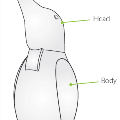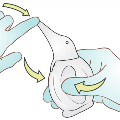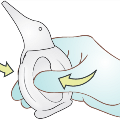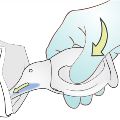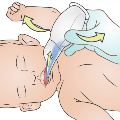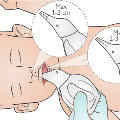
ComWeld StatVac II / Laerdal Compact Suction Unit (LCSU4):
- To clear secretions in order to maintain a patent airway.
Penguin Suction Device:
- To remove fluids from oral and nasal cavities of the newborn.
ComWeld Statvac II
- Clean portable unit after every use.
- Ensure the suction container in the suction unit does not get over 2/3 full.
- Take care when suctioning the newborn/neonate. Utilise the baby mucus extractor if available.
ComWeld Statvac II & Laerdal Compact Suction Unit (LCSU4)
- Replace tubing and oropharangeal aspiration flexible catheter after every use.
- Constantly flush the suction catheter and tubing with water to prevent occlusion.
Penguin Suction Device
- The suction tip should not be inserted more than 1-2cm into the nasal cavity or 2-3cm into the oral cavity (Fig. 6)
- Ensure all suctioned material is collected into a bluey to minimise contamination.
- Although the unit can be sterilised and re-used, this item is single patient use only for all St John Ambulance Staff.
Tracheostomy
- For tracheostomy suction, refer to Tracheostomy for further information
- All relevant infection control methods to be utilised.
- Prepare equipment required:
- Suction tubing
- Suction unit
- Yankauer / Ducanto catheter OR Flexible Aspiration Catheter
- Connect catheter to suction unit:
ComWeld StatVac O2-driven aspirator OR Laerdal Compact Suction Unit (LCSU4) - SUCTION EQUIPMENT SHOULD BE ONLY BE TAKEN OUT OF PACKAGING WHEN USE IS REQUIRED
Laerdal Compact Suction Unit (LCSU4)
- Push the suction jar connection into the vacuum inlet and ensure the lower lip of the canister clicks in place.
- Connect the patient suction tube to the suction port, ensuring all connections are secure to prevent leakage.
- Unwind the patient suction tube (check that no kinks will obstruct flow).
- Turn the unit “ON” by pressing the green power button.
- Set desired suction vacuum level by blocking the suction tube and turning the vacuum regulator.
- Turn clockwise ( + ) to increase vacuum
- Turn counter-clockwise ( - ) to decrease vacuum
- The vacuum level will display on the 50 – 550+ mmHg scale.
- When the desired vacuum level is reached, unblock the suction tube; when blocked, the suction unit should return to the desired level.
- The LED scale illuminates green to indicate the level of the vacuum/suction strength.
- The ‘Light Blue’ area indicates reduced suction levels for infants and small children.
- Connect the catheter to the suction tubing.
ComWeld StatVac II:

Laerdal Compact Suction Unit (LCSU4):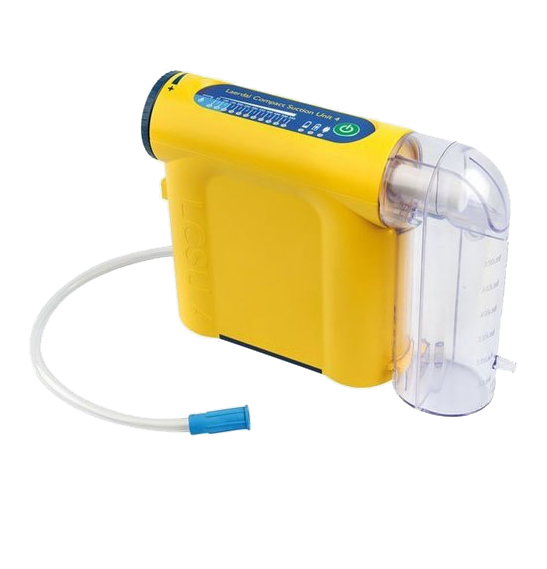
Flexible Aspiration Catheter (oropharynx only):
- Measure maximum length of the catheter to be inserted into the patient’s mouth by measuring the distance from the corner of the nostril of the patient to the earlobe. Hold the catheter with thumb and index finger at the length measured.
- Insert catheter tip into the oropharynx under direct view.
- Aspirate by occluding the aperture on the Soft Suction catheter while withdrawing slowly.
- Aspiration must only be performed for a maximum of 5 seconds at one time.
- Do not aspirate while entering the oropharynx.
Flexible Aspiration Catheter (Endotracheal tube):
- Measure catheter length against the length of an equivalent ETT and clearly mark.
- Insert catheter into the endotracheal tube.
- Aspirate and rotate the catheter while withdrawing.
Flexible Aspiration Catheter (Tracheostomy):
- Insert catheter into the tracheostomy (maximum of 15cm).
- Request the patient cough.
- Aspirate while withdrawing the catheter.

Yankauer or Ducanto Suction catheter (oropharynx only):
- Yankauer catheters have a narrower bore for blood and secretions
- Ducanto catheters are a larger bore option where needed and available
- Insert Yankauer or Ducanto tip into the oropharynx under direct view.
- Aspirate by occluding the Yankauer vacuum relief hole while withdrawing slowly (Ducanto does not have a vacuum relief hole)
- Aspiration must only be performed for a maximum of 5 seconds at one time.
- Do not aspirate while entering the oropharynx



Penguin Suction Device:
- Remove device from packaging.
- Lay out open bluey for collection of aspirations.
- Check suction device is functioning by blocking the suction tip and squeezing the body. The body should not expand until the blockage is removed (Fig. 2)
- If functioning, squeeze body of Penguin and hold (Fig. 3).
- Place suction tip into oral or nasal cavity.
- Release grip slowly, allowing suction to occur (Fig. 4).
- Remove and discard aspiration by squeezing out onto bluey for collection (Fig. 5)
- Repeat steps 4-7 as required.
- Consider lateral position / gravity assistance draining if amount of fluid or secretions exceeds suction capacity of suction unit.
| Settings | |
|---|---|
| Extended Care: | |
| Colour assist: | |
Document Control
Clinical Resources Website
St John Ambulance Western Australia Ltd (ABN 55 028 468 715) (St John WA) operates ambulance and other pre-hospital clinical services. St John WA’s Clinical Resources, including its Clinical Practice Guidelines (Clinical Resources), are intended for use by credentialed St John WA staff and volunteers when providing clinical care to patients for or on behalf of St John WA, within the St John WA Clinical Governance Framework, and only to the extent of the clinician’s authority to practice.
Other users – Terms of Use
The content of the St John WA Clinical Resources is provided for information purposes only and is not intended to serve as health, medical or treatment advice. Any user of this website agrees to be bound by these Terms of Use in their use of the Clinical Resources.
St John WA does not represent or warrant (whether express, implied, statutory, or otherwise) that the content of the Clinical Resources is accurate, reliable, up-to-date, complete or that the information contained is suitable for your needs or for any particular purpose. You are responsible for assessing whether the information is accurate, reliable, up-to-date, authentic, relevant, or complete and where appropriate, seek independent professional advice.
St John WA expressly prohibits use of these Clinical Resources to guide clinical care of patients by organisations external to St John WA, except where these organisations have been directly engaged by St John WA to provide services. Any use of the Clinical Resources, with St John WA approval, must attribute St John WA as the creator of the Clinical Resources and include the copyright notice and (where reasonably practicable) provide a URL/hyperlink to the St John WA Clinical Resources website.
No permission or licence is granted to reproduce, make commercial use of, adapt, modify or create derivative works from these Clinical Resources. For permissions beyond the scope of these Terms of Use, including a commercial licence, please contact medservices@stjohnambulance.com.au
Where links are provided to resources on external websites, St John WA:
- Gives no assurances about the quality, accuracy or relevance of material on any linked site;
- Accepts no legal responsibility regarding the accuracy and reliability of external material; and
- Does not endorse any material, associated organisation, product or service on other sites.
Your use of any external website is governed by the terms of that website, including any authorisation, requirement or licence for use of the material on that website.
To the maximum extent permitted by law, St John WA excludes liability (including liability in negligence) for any direct, special, indirect, incidental, consequential, punitive, exemplary or other loss, cost, damage or expense arising out of, or in connection with, use or reliance on the Clinical Resources (including without limitation any interference with or damage to a user’s computer, device, software or data occurring in connection with such use).
Cookies
Please read this cookie policy carefully before using Clinical Resources from St John WA.
The cookies used on this site are small and completely anonymous pieces of information and are stored on your computer or mobile device. The data that the cookies contain identify your user preferences (such as your preferred text size, scope / skill level preference and Colour Assist mode, among other user settings) so that they can be recalled the next time that you visit a page within Clinical Resources. These cookies are necessary to offer you the best and most efficient possible experience when accessing and navigating through our website and using its features. These cookies do not collect or send analytical information back to St John WA.
Clinical Resources does integrate with Google Analytics and any cookies associated with this service enable us (and third-party services) to collect aggregated data for statistical purposes on how our visitors use this website. These cookies do not contain personal information such as names and email addresses and are used to help us improve your user experience of the website.
If you want to restrict or block the cookies that are set by our website, you can do so through your browser setting. Alternatively, you can visit www.internetcookies.com, which contains comprehensive information on how to do this on a wide variety of browsers and devices. You will find general information about cookies and details on how to delete cookies from your device. If you have any questions about this policy or our use of cookies, please contact us.

